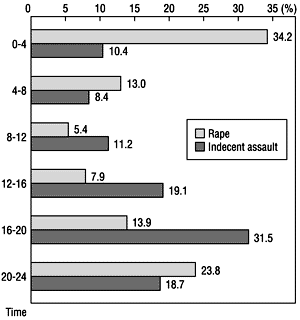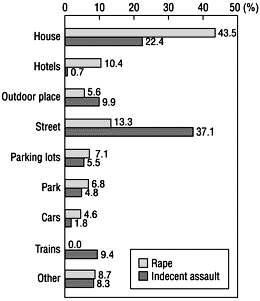-
Violence against women
Matters involving women that are perceived as human rights issues
Discriminatory treatment of women in the workplace was the foremost matter involving women which was perceived as a human rights issue. This was followed by sexual harassment in the workplace, stereotyping of gender roles ("men work and women stay in the home," etc.) and prostitution (including high school girls having casual sexual relations with older men), etc. (Figure 29).Figure 29: Matters relating to women which are perceived as human rights issues (multiple response)

Notes:
- *1
- Sexual harassment in the workplace.
- *2
- Forcing stereotyped gender roles on others ("men work, women stay at home," etc.)
- *3
- Domestic violence against wives by husbands (hitting one's wife when drunk, etc.)
- *4
- Terms which are only applied when speaking about women such as "someone else's wife," "wife," "widow," etc.
- *5
- Ads using women in bathing suits, nude or in sexually suggestive poses which have nothing to do with the content of the ad.
Source:
Compiled from Public Opinion Survey on Human Rights' Protection (1997), Prime Minister's Office
Rape and indecent assault
The number of cases reported and the number of arrests made increased during 1997 compared to the previous year for both rape and indecent assault (Figure 30).Figure 30: Trends in number of arrests, etc., for rape and indecent assault

Notes:
"Rape" numbers include mugging and rape.
Source:
National Police Agency statistics
Actual situation in terms of sexual crimes
In terms of the time periods in which rapes occurred, more than half of rapes were committed over the eight hours between eight in the evening and four in the morning, while the most common location was the house, followed by the street. More than half of indecent assaults occurred over the eight hours between mid-day and eight in the evening, with the most common location being the street, followed by the house (Figure 31).Figure 31: (1) Ratio of known cases by time period

(2) Ratio of known cases by location

Source:
National Policy Agency statistics (1997)
Attitudes to prostitution
In regard to prostitution and the parties involved, a larger ratio of respondents felt that compared to cases where both parties were adults, prostitution was not acceptable where one party was underage, with the number of respondents condoning prostitution decreasing (Figure 32).Figure 32: Attitudes to prostitution

Notes:
"Other" responses have not been included here.
Source:
Compiled from Public Opinion Survey on Gender Equal Society (1997), Prime Minister's Office
Dividing into age-groups those respondents who condoned prostitution (those who thought that where there was consent by both parties, prostitution was not good but couldn't be helped, or else was not to be censured at all), particularly where there was consent by both parties, more than half of male respondents condoned prostitution. More than 20% of men in their 20s and 30s responded that they condoned prostitution even where one party was underage (Figure 33).
Figure 33: Attitudes to prostitution

Notes:
This figure is the result of a simple calculation of the ratio of those who, when questioned on their attitude to prostitution and the parties involved, responded either that where both parties consented, there was no need for censure or that where both parties consented, it wasn't good but couldn't be helped, with this then divided into cases of prostitution between adults and cases where one party was underage.
Source:
Compiled from Public Opinion Survey on Gender Equal Society (1997), Prime Minister's Office
Stalkers
While few respondents had personal experience of stalkers, those who tail their victims and make persistent phone calls, etc., around half were aware of stalkers in one form or another (Figure 34).Figure 34: Experience with stalkers (multiple response)

Notes:
- *1
- Know someone who is being or has been pursued by a stalker.
- *2
- Don't know anyone who is being or has been pursued by a stalker, but know that stalkers are being discussed by TV and newspapers.
- "Other" and "No Opinion" responses have been omitted.
- Because responses were multiple, the total exceeds 100%.
Source:
Compiled from Public Opinion Survey on Gender Equal Society (1997), Prime Minister's Office
A characteristic of this issue is that the younger the respondents, the greater the ratio of those (both men and women) who either have had personal experience of stalkers or know of persons who have been stalked.
Cabinet Office Home > Gender Equality Bureau Cabinet Office > Gender Equality in Japan > White Paper > The Present Status of Gender Equality and Measures > The Present Status of Gender Equality and Measures
